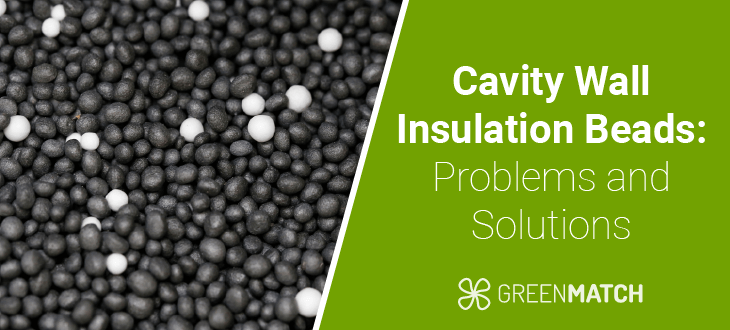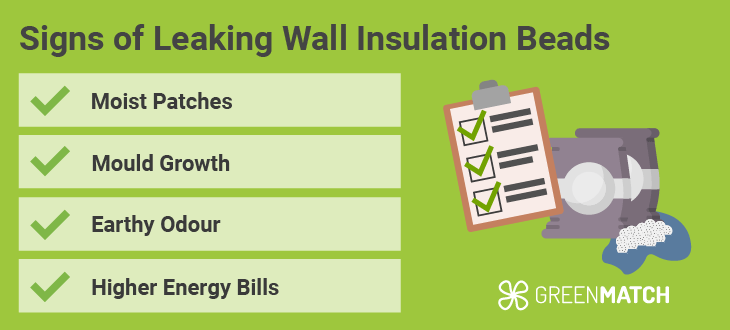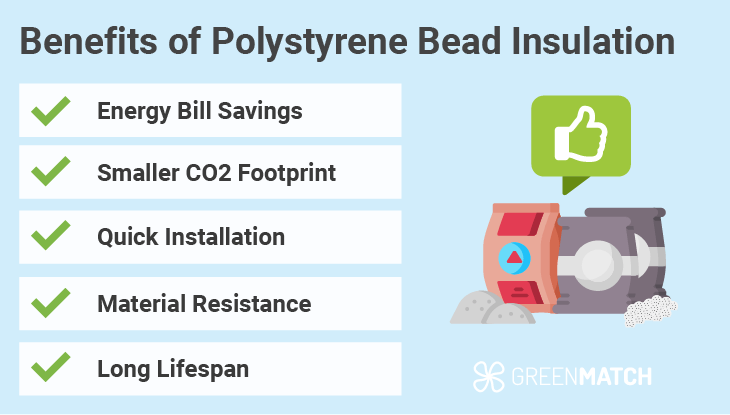Answer these simple questions and we will find you the BEST prices
Which type of solar quotes do you need?
It only takes 30 seconds
100% free with no obligation

Get Free quotes from insulation specialists near you

Save money by comparing quotes and choosing the most competitive offer

The service is 100% free and with no obligation
- GreenMatch
- Insulation
- Wall Insulation
- Cavity Wall Insulation
- Cavity Wall Insulation Beads
What Is the Problem With Cavity Wall Insulation Beads?


- Detached homes with cavity wall insulation can save up to £405 on annual energy bills.
- The most common cavity wall insulation beads are bonded EPS polystyrene beads.
- Bonded EPS polystyrene beads typically cost around £18 - £22 per m2.
Around 71% of all properties in the UK are made of cavity walls, and yet according to the Department for Energy Security & Net Zero, over a quarter of these properties lack proper cavity wall insulation. For some, it’s a matter of choosing the right insulation material.
In recent years, insulation beads have been steadily gaining popularity as a method of insulating cavity walls. The most popular, being bonded EPD polystyrene beads - even boasts amazing qualities such as moisture and mould resistance. But what are some issues you can encounter?
This complete guide by GreenMatch UK will provide all you need to know about cavity wall insulation beads, including common problems, solutions, and benefits.
Ready to get your cavity walls insulated? Look no further than GreenMatch UK for the best bargains on professional installers. Simply fill in our quick 30-second form, and receive up to 3 free home-tailored quotes from trustworthy installers right in your area. Click below to begin!
Fill in the form in just 1 minute
What are the problems with cavity wall insulation polystyrene beads?

EPS-bonded polystyrene beads have taken the cavity wall insulation market by storm. Their relatively cheaper price, durability to weathering, and recyclability make them a popular choice amongst homeowners with cavity walls.
But like any insulation choice, cavity wall insulation polystyrene bead problems also exist and are worth considering. Here are some of the main issues to look out for:
- Over-bonding or under-bonding: Cavity wall insulation beads - like EPS polystyrene beads - are secured in the cavity by using a bonding agent or ‘glue’ of sorts. In some poor installations, this glue can be too strong or too weak, causing a series of related problems such as over-stuck beads, or loose beads.
- Cavity wall gaps: In instances where the bonding agent can wear down, beads can become loose and create gaps in your cavity wall insulation. This can invite moisture collection, clinging to or even penetrating your internal walls.
- Moisture build-up: While EPS polystyrene beads are moisture and mould-resistant themselves, it does not mean they can repel it from your cavity walls. Poor installation jobs can create cracks and gaps which can build up moisture over time.
Being aware of these blown bead insulation problems can help you prepare for solutions if ever needed. The best way to reduce the likelihood of cavity wall issues is to work with a professional installer. That way, you can ensure that you get a high-quality job.
Overbonding of the beads
When the bonding agent used to secure cavity wall insulation beads in place is too strong, you risk overbonding the beads. This can make them rigid and cause pressure buildup.
The mounting pressure can lead to cracks in your external walls, which can allow for moisture to enter the cavity space via the over-hardened glue. This moisture buildup can seep into your internal walls and lead to a damp home environment.
Under-bonding of the beads
On the other hand, when the bonding agent used for cavity wall insulation beads is too weak, you risk underbonding the beads. This can cause the beads to dislodge and gaps to form around them.
These gaps can be susceptible to moisture build-up, but can also invite insects like ants to harbour in them. Ants are known to build nests in some cavity walls, bringing in soil around the loosened beads to create nest structures.
This soil buildup in your cavity space can transfer moisture from the external wall to the internal wall, bridging the gap and leading to a damper home environment.
Moisture build-up
In most cases, the greatest risk for any cavity wall insulation is moisture build-up. In the case of polystyrene beads overbonding and underbonding can lead to moisture buildup in the cavity space.
While EPS polystyrene beads are moisture and mould-resistant, this doesn’t mean they can protect a cavity wall from moisture if it’s poorly sealed. Cracks in the external brickwork can still lead to moisture seeping through and reaching the internal wall.
For this reason, it’s important to work with a professional and accredited installer who can ensure that the job is done with the highest quality workmanship.
Beads leaking and escaping
A problem common with under-bonded beads is that these loose beads are no longer secured in place. This can create shifting gaps throughout your cavity wall, exposing areas prone to moisture buildup.
Additionally, any time external brickwork might need to take place, under-bonded beads can flow out onto your lawn and pavement, reducing the insulation in your cavity walls, but also causing a mess in your lawn.
How can you tell your cavity wall insulation beads are leaking?

It’s sometimes difficult to identify when exactly your insulation beads have been compromised, but there will be signs. It’s good to keep an eye out for anything out of the ordinary so that you can identify a problem before it worsens.
Cavity wall insulation beads leaking can be triggered by a series of problems. Here are some of the most telltale signs of leaking insulation beads:
- Moist patches: If you are noticing patches of dampness on your internal walls, this is most often because there’s a moisture buildup in the cavity space. Problems like external wall cracks and loose insulation beads can lead to this.
- Mould growth: If you notice your home has become more susceptible to growing mould suddenly, it can indicate an increase in inner wall moisture. This is most often due to compromised insulation in the cavity space.
- Earthy odour: A musty earth-like odour in your home may indicate moisture and mould within the cavity space of your walls. This damp smell can point to underlying moisture issues.
- Higher energy bills: If your insulation beads are leaking, chances are your insulation will start to underperform. If your energy bills seem higher than usual, or your home seems worse at regulating temperatures, a cavity wall insulation check may be in order.
Cavity wall beads escaping can add a damper to your insulation through hefty repair costs and top-ups, however, being proactive can help you avoid facing these problems.
How to avoid problems with bead cavity wall insulation
Like any insulation measure, it’s possible to encounter problems along the way. However, the majority of these problems stem from shabby installation, poor workmanship, and unsuitable cavity walls.
Luckily, some proactive steps can be taken ahead of time to make sure you get the best out of your cavity wall insulation job.
- Prepare your cavity walls: Older homes can benefit from a property assessment to make sure the cavity walls are up to par. This includes fixing any gaps and cracks in the outer wall to ensure a proper seal, having adequate ventilation, cleaning out the cavity space, relocating any wires, and more. A professional installer should handle this.
- Check existing insulation: Some cavity wall properties have already been previously insulated. In some cases, this insulation is no longer effective and must be removed. While this can be a costly job, luckily insulation grants in the UK provide coverage to qualifying households for this job.
- Work with a professional: Perhaps the best piece of advice is the really vet and research the installer you work with. Aim for installers that are certified by the Cavity Insulation Guarantee Agency (CIGA). This seal of approval makes sure you get quality workmanship, as well as a 25-year guarantee on your cavity wall insulation job.
If you follow these steps before getting your cavity walls insulated with beads, you maximise your chances of a long-term insulation solution for your home.
Advantages of cavity wall insulation beads

Cavity wall polystyrene beads boast some of the most impressive properties of all cavity wall insulation materials. Together with their relative affordability and robustness, a correct installation can reduce your home’s heat loss by up to 33% for decades to come.
That’s not all. Take a look at some of the best perks you can enjoy with polystyrene bead cavity wall insulation:
- Energy bill savings: A proper cavity wall insulation with polystyrene beads can see you save up to £405 in annual energy bills for a typical detached UK home. This is because your home will experience less heat loss, making your heating system work less to constantly top off lost heat.
- Smaller CO2 footprint: An energy system that works less means it consumes less energy. That way, a properly insulated cavity wall can reduce your domestic carbon footprint by up to 1.1 tonnes every year. If that sounds like a lot, it’s because it is!
- Quick installation: Cavity wall insulation installation is one of the fastest and most non-invasive ways to insulate a wall. Taking place entirely from the outside of your home, the process can take just 1 -2 hours to complete.
- Material resistance: Cavity wall insulation beads - EPS polystyrene - is arguably the most robust insulation material on the market for cavity walls. They are entirely moisture and mould-resistant, making sure that they retain their insulation properties for decades to come.
- Long lifespan: Cavity wall insulation beads have a lifespan that can typically last the lifetime of your property if installed correctly! In any case, working with a CIGA-guaranteed installer will also give you a 25-year warranty to rely on.
With the perks that cavity wall insulation beads bring, it’s safe to say they outweigh the downsides. A great way to ensure longevity and peace of mind with your cavity wall insulation is to work with a professional installer.
However, finding an accredited installer at the right price is no easy task. Research and vetting can have you spend countless hours surfing the internet and scheduling calls, with no real deal in sight. Luckily, GreenMatch UK is here to free you from the burden.
Through our nationwide network of trusted installers, you can receive up to 3 free home-tailored quotes completely free of charge and obligations. All you have to do is fill in our simple 30-second form, and we’ll deliver the bargains to you. Click below to begin!
Fill in the form in just 1 minute
FAQ
Bead cavity wall insulation in itself does not cause dampness. Most often, a poor installation job, our outdated damaged cavity walls can create insulation gaps that invite moisture buildup. The best way to avoid this issue is to work with a professional accredited installer. That way, you can rest assured to get the highest quality workmanship.
Polystyrene beads are one of the more popular and effective ways to insulate your cavity walls. Alongside their favourable price tag, polystyrene beads are moisture and mould-resistant. They can even be recycled after use into new products, making them relatively sustainable.
If installed correctly, bead cavity wall insulation can last the entire lifetime of your home. For extra safety, work with a CIGA-guaranteed installer. The Cavity Insulation Guarantee Agency (CIGA) vets installers for their workmanship, and provides a 25-year guarantee on cavity wall insulation jobs.
There is no real bad type of cavity wall insulation, but rather a bad cavity wall or bad installation job. Bad cavity walls are more often found in older properties and have cracks, gaps, and unclean cavity spaces that need fixing before an insulation job.

Akif is a copywriter at GreenMatch since 2023. With a keen interest in community sustainability, green solutions and the role of digital media in identifying climate trends, he aims to hone in on his background in International Studies and Digital Media to provide a multidisciplinary approach to written content rooted in credible research and accuracy.
We strive to connect our customers with the right product and supplier. Would you like to be part of GreenMatch?

